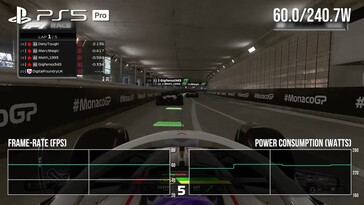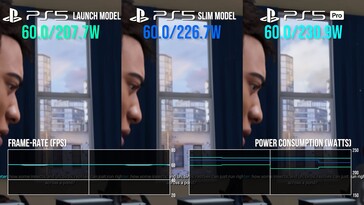The Sony PlayStation 5 Pro officially went on sale on November 7 at a price of $699.99 in the US. For an extra $200 over the launch MSRP of the base PS5, the PS5 Pro promises a much more powerful GPU aided by Sony’s proprietary PSSR upsampling tech, the same Zen 2 CPU but with a 10% higher clock speed, and 2 GB of extra DDR5, to name a few upgrades. These upgrades should allow the PS5 Pro to perform noticeably better in both PS5 Pro-enhanced and standard PS5 titles.
Unsurprisingly, the PS5 Pro’s added performance comes at the cost of increased power consumption. Digital Foundry has measured a small but noticeable energy usage delta between the base PS5 and the PS5 Pro. Curiously, DF’s PS5 Slim console seemed to have a lower-binned SoC, resulting in considerably higher power consumption vs the base PS5.
PS5 Pro vs PS5 power consumption
Starting first with Elden Ring with the “Quality” mode enabled, the PS5 Pro consumes around 228 to 230 W while the vanilla PS5 consumes less energy at around 215 to 218 W. The PS5 Slim is the anomaly here. Using a 6 nm SoC, the Slim console should consume around the same or lower power vs the base PS5 but DF’s PS5 Slim console uses virtually the same amount of energy as the PS5 Pro (Available on Amazon).
Next up, the PS5 Pro uses around 230+ W in Marvel’s Spider-Man 2 whereas the base PS5 consumption fluctuates between 200-216 W. The PS5 Slim, once again, is the odd one out, since it uses noticeably more power than the base PS5.
Finally, the PS5 Pro's power consumption hovers above 230 W, touching a maximum of 240 W, in F1 24 running in the “Quality” mode.
PS5 Pro brings some noticeable image quality improvements
The increase in power consumption for the PS5 Pro coincides with improvements to image quality, better RT, and enhanced/stable frame rates. For instance, DF notes that the PS5 Pro offers a 30-35% performance increase in Elden Ring in the “Quality” mode, even though the game hasn’t been explicitly enhanced for the Pro console. This results in frame rates that consistently stay above 50 FPS. In contrast, the base PS5 sees the frame rate fluctuate between low-to-mid 40s, even dropping to high 30s on occasion.
The Elden Ring result is pretty impressive since the console only consumes around 12 W or 5.5% more energy to deliver an up to 35% faster performance.
For RT upgrades, a good game to show the improvements brought by the PS5 Pro is Alan Wake 2. Per DF, the title brings a good implementation of ray-traced reflections in its 30 FPS RT mode. Similarly, F1 24 also enjoys RT reflections and RT Ambient Occlusion on top of the options present in the base PS5 version.
If you want a deeper dive into the upgrades offered by the PS5 Pro like PSSR, check out DF’s PS5 Pro review linked below.





























